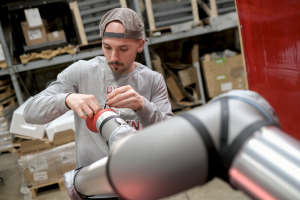Subscriber Benefit
As a subscriber you can listen to articles at work, in the car, or while you work out. Subscribe Now
Automated welding machines are nothing new. In fact, they’ve been around for decades. But Indianapolis-based THG Automation is one of several companies that have begun filling a need for more user-friendly devices that can easily adapt for a variety of jobs.
THG’s CEO, Matt Hendey, said customers can buy one of his company’s off-the-shelf solutions, put it on the factory floor and, “within an hour, you can be programming parts and welding.”
Hendey started down his current path in 2009, when he opened a manufacturing consultancy called Hendey Group.
“My original intention was to do robotics consulting,” he said.
But his work helping manufacturers develop in-house robotics programs became ever more “hands on,” until he and his slowly growing staff found themselves actually helping to build such systems. Business was good, so in 2017 Hendey moved to his current address and started adding employees.
“We wanted to grow past some of the one-man-band stuff I’d been doing in the past,” he said.
By 2019, the company was focused on rapid prototyping and software and hardware development. That year, Elwood-based Dunn-Rite, which makes water-related recreational items such as poolside basketball goals and floating coolers, got in touch. Its metal basketball hoops (and other items) required welding, but Dunn-Rite had trouble getting and keeping good welders. So the company asked Hendey to develop a robotic system.
It wasn’t exactly in his wheelhouse, but it seemed interesting and unique, so he put in a bid for the job. But it wasn’t until June 2020, in the midst of the pandemic, that his company got the green light to proceed.
“We started the project thinking it was a one-off,” Hendey said. “But as we worked on it and wrote the software and created the components and did the engineering, we decided it was a product.”

Going small
What Hendey Group created was basically a welder-equipped robot arm attached to a table. Other than the fact that it was much smaller, it didn’t look all that different from traditional automated welding systems.
However, those units are typically very large, cost hundreds of thousands of dollars, and require a lot of intricate programming to do one specific task. That makes them best suited for welding thousands or tens of thousands of the same thing. They typically have to do this in an isolated, walled-off corner of the factory, because the fast-moving robots are so inherently dangerous that humans aren’t allowed anywhere near them while they work.
Which is where THG’s system comes in. Its 75-pound robotic arm is supplied by a company called Universal Robots, and the welding power source and equipment by an Australian firm named Fronius. THG integrates the hardware and contributes its own proprietary software, allowing each unit to quickly switch from one welding task to another, using a touchpad.
This makes its lineup of customizable robots ideal for what are called high-mix, low-volume jobs. In other words, cranking out 50 of something instead of 50,000. And you don’t need a programmer to run the thing. Just someone on the shop floor who’s had a couple of hours of training.
“They just change out the tooling, based on which product they’re running,” said THG industrial designer Robert Sibley. “Then they change the program number in the robot and just press go. It’s a turnkey solution.”
And employees needn’t keep their distance while the system does its work. Built-in sensors allow the robot to veer off if it accidentally brushes against a human. Sibley said that, at worst, the contact feels like “a light sucker punch.”
Realizing the company had a potential winner on its hands, Hendey changed the company’s name to THG Automation and started showing off the Dunn-Rite robot (which the company didn’t immediately need), to potential customers. Before long, THG started getting orders. The company now offers several customizable versions of its “cobots,” which are designed to work close to a human overseer.
THG outsources most of the construction of these welders, because there’s simply no room at its small Indianapolis headquarters just north of the Indiana State Fairgrounds.
This human-robot tag team approach to welding opens up some intriguing possibilities, said Gary Konarska II, executive director and CEO of the American Welding Society trade group.
“If you have some boring, repetitive work that needs doing, have the cobot do it,” Konarska said. “And then a human welder does stuff that’s more complicated or demanding. Having the human do more complicated stuff makes the company more profitable, which helps it grow. That’s why they often say that robots actually create more jobs rather than take them away.”

Filling the welder shortage
THG couldn’t have brought its systems to market at a better time, because a perfect storm of challenges has made such automated systems increasingly popular.
On the one hand, manufacturers want to alleviate supply chain snarls by reshoring their factory work to get it closer to customers. But according to the AWS, the U.S. industry will need 360,000 new welders by 2027—at the same time some 155,000 current welders approach retirement.
“Welding is just a small part of the work that needs to be done to reshore industry back to this country,” said Doug Rhoda, a three-decade member of the AWS’ Robotic and Automatic Welding Committee. “In order to compete, especially with a shortage of skilled welders, we need tools like this. Tools like cobot welding are an enabler so that we can keep and grow manufacturing in this country.”
In addition to serving with the AWS, Rhoda is founder and chairman of Loveland, Colorado-based Vectis Automation—which is one of several companies, large and small, making cobot welders nationwide.
“THG and Vectis were two of the early ones,” Rhoda said. “Since then, it’s become very popular. I tell our team that imitation is the sincerest form of flattery, and we’re very flattered because there’s a lot of imitation.”
Several national and Indiana-based manufacturers have purchased THG systems.
Eric Odmark, president of Indianapolis-based contract manufacturer IMH Products, has found plenty of work for the unit he’s purchased. The company makes a lot of parts for a lot of products, including construction equipment and military vehicles. It also owns a couple of old-school industrial welding units, which are great for big jobs but next to useless for the many smaller gigs IMH takes on.
“Our high-volume robots could cost us $10,000 to $30,000 in tooling and take six to eight weeks of programming work to set up for a new job,” Odmark said. “If you’re going to run the same part for five years, it makes sense, because once it gets going, it can move quickly.”
It makes a lot less sense, however, for the company’s low-volume, high-mix jobs. For that, it now has one of THG’s cobots, which can be reconfigured from one job to the next in hours rather than weeks. They’re a bit slower than the big industrial models, but they’re also vastly cheaper and less of a pain in the backside. Plus, if there’s ever a problem, THG is right down the road.
“Matt [Hendey] will come right over and help us troubleshoot stuff if we have any questions,” Odmark said. “We like working with him.”
Another early adopter was Indianapolis-headquartered America’s Wood-Mizer, which makes, among a great many other things, sawmills and ancillary equipment. Business was booming, but America’s Wood-Mizer couldn’t find enough welders to do all the work. And the old-school robotic welders it already owned were inappropriate for its many smaller jobs.

“We started looking for a solution back at the end of 2020,” said Darryl Floyd, president of America’s Wood-Mizer. “We wanted something small and easy to program that we could easily move around, which we couldn’t do with our big welders.”
The company ended up acquiring 10 THG cobots, thanks to an unsolicited sales pitch from the then-fledgling robotics firm. Just before Floyd dumped the email to his spam bin, he noticed that the company offering him small, easy-to-program welding robots (exactly what he needed) was in Indianapolis. Floyd and his team visited the company and watched a demonstration.
“We saw it and played with it a little bit, and we were on board,” he recalled. “We were on board when they were just starting out. I think they may have only sold one or two machines at that point.”
Branching out
THG said that, though it’s a natural fit for the aforementioned “high-mix, low-volume” jobs, the company is also approaching traditional large manufacturers who need a zillion copies of one part. Hendey said that, although THG’s machine is fairly small and quickly reconfigured, it can still weld a whole lot of one thing.
“We have one customer who uses a THG robot, and it just spits out parts for Toyota all day long,” he said.
Nevertheless, Konarska said helping out smaller subcontractors is the sweet spot for welding cobots.
Those companies might “build for multiple manufacturers, and they never really know what they’re going to be building in six months,” he said. “With cobots, they don’t care, because they’re flexible. It’s opened up their envelope of possibilities dramatically.”
Konarska said there’s little danger that cobots will take human jobs, either in the short or medium term. Because right now, in his estimation, all they’re doing is filling positions that no one seems to want.
“We’re so far away from having enough welders that I can’t see that happening anytime soon,” he said.
Currently, THG can push out roughly three cobots per week, max. But it’s already shopping around for more workspace, and its current staff count of 11 will likely grow.
The company declined to disclose annual revenue, but Hendey said THG grew around 60% last year, and he’s looking for similarly aggressive expansion this year. One of the only things holding the company back is persistent supply chain problems.
“We think there’s a lot of market share out there that we can capture,” he said. “I could see $500 [million], maybe $750 million in business in this segment.”•
Please enable JavaScript to view this content.
